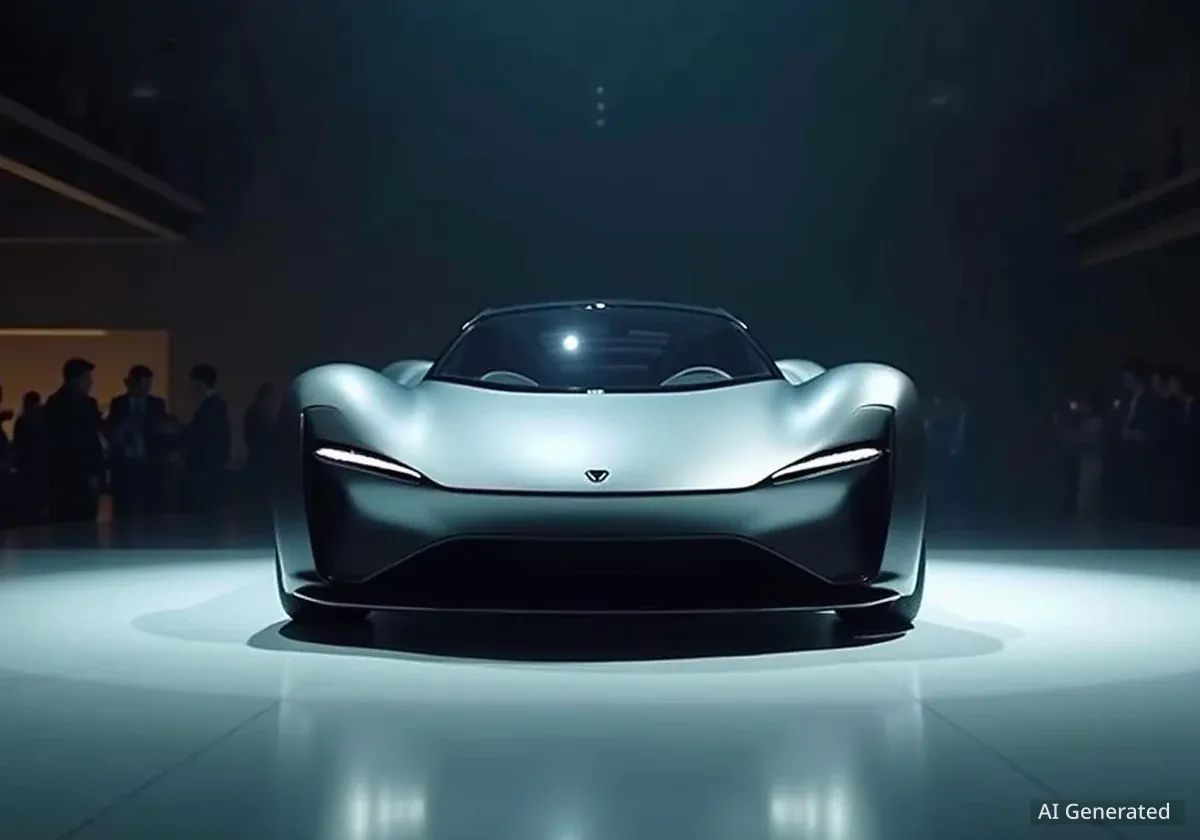American startup Vittori has officially introduced its first vehicle, an unnamed hybrid hypercar boasting 1,110 horsepower. The car, which was developed in collaboration with the renowned Italian design house Pininfarina, made its debut in Miami. The company states the vehicle's creation involved the use of "future-forward technology," hinting at the integration of artificial intelligence in its design process.
This new entry into the exclusive hypercar market combines a powerful V-12 hybrid engine with advanced engineering. With production limited to just 50 units, Vittori aims to compete with established names in the high-performance automotive sector.
Key Takeaways
- Vittori, a new American automotive startup, has revealed its first hypercar.
- The vehicle features a 6.8-liter V-12 hybrid powertrain producing a combined 1,110 horsepower.
- Design was a collaborative effort with the celebrated Italian firm Pininfarina.
- Production will be limited to only 50 examples worldwide, with manufacturing set to take place in Italy.
- The car can accelerate from 0 to 62 mph (100 km/h) in an estimated 2.5 seconds.
A New Contender in the Hypercar Arena
The high-performance vehicle market has a new participant. Vittori, an American company, recently showcased its inaugural hypercar at an event in Miami. While the vehicle does not yet have an official name, its specifications and design partners have already drawn attention.
The project is a significant collaboration with Pininfarina, a name synonymous with iconic automotive design for decades. Vittori also partnered with Italtecnica, an Italian engineering firm known for developing high-performance powertrains, to create the car's engine and hybrid system.
Who is Pininfarina?
Pininfarina is an Italian car design firm and coachbuilder founded in 1930. The company has been responsible for designing some of the most famous cars in history, particularly for brands like Ferrari, Alfa Romeo, and Maserati. Their involvement lends significant design credibility to new automotive projects.
Design Language and Aerodynamics
The exterior and interior of the Vittori hypercar reflect a modern approach to performance aesthetics. The design shares some visual cues with other established supercars but incorporates unique elements to define its identity.
Exterior Features
The vehicle's overall shape is comparable in size to the Lamborghini Revuelto. According to observers, its profile is reminiscent of the McLaren GT, particularly in the front end. Key design features include:
- A distinctive hexagonal front grille flanked by two large air intakes.
- Very narrow, horizontally oriented headlights that contribute to an aggressive stance.
- A complex rear design featuring angular taillights and centrally located quad exhaust pipes.
- A prominent rear diffuser with vertical strakes for improved aerodynamics.
- Bronze-colored accents that contrast with a deep blue exterior paint finish.
This combination of elements creates a vehicle that is both visually striking and aerodynamically functional, a critical requirement for cars capable of extreme speeds.
Interior Cabin and Controls
Inside, the cabin is driver-focused and utilizes a clean, modern layout. The design appears to prioritize function while maintaining a premium feel. The interior is characterized by a distinct partition that separates the driver and passenger areas, creating individual cockpits.
A large, vertically oriented touchscreen serves as the central interface for infotainment and vehicle controls, positioned above two air vents. Behind the steering wheel, a digital instrument cluster provides the driver with essential performance data. The overall impression is one of minimalist, tech-forward luxury, consistent with contemporary hypercar design.
Powertrain and Performance Metrics
At the core of the Vittori hypercar is a bespoke powertrain developed by Italtecnica. The system is a hybrid, combining a large internal combustion engine with an electric motor to achieve its high-performance figures.
Performance at a Glance
- Engine: 6.8-liter V-12
- Hybrid System: Single electric motor on the front axle
- Total Power Output: 1,110 horsepower
- 0-62 mph (100 km/h): 2.5 seconds (estimated)
The 6.8-liter V-12 engine provides the majority of the power, while the front-axle electric motor assists with acceleration and likely enables all-wheel-drive capability. This configuration allows for rapid acceleration, with an estimated 0-62 mph time of 2.5 seconds. This places the Vittori hypercar in direct competition with vehicles from established brands like Ferrari and Koenigsegg. While the company has not yet released a top speed, it has assured that the figure will be appropriate for a vehicle in this class.
"Our dream was to create a beautiful, high-speed vehicle that evoked emotion and a sense of connection," stated Carlos Cruz, Founder and CEO of Vittori. "We sought to build a reality where performance, beauty, control, and freedom could exist in one car—without compromise."
The Role of Advanced Technology
Vittori has marketed its creation as the world's first "AI hypercar." However, the company's official materials are more subdued, referring to the use of "future-forward technology" in its development. This suggests that artificial intelligence may have been used as a tool to accelerate or optimize the design and engineering phases, rather than designing the car entirely on its own.
This approach is becoming more common in the automotive industry. Companies like Alpine have publicly acknowledged using AI to assist their designers, helping to explore a wider range of possibilities and speed up the development timeline. The use of such technology can help new startups like Vittori compete with the vast resources of legacy automakers.
Production Plans and Market Availability
Vittori has confirmed that its first prototype is fully functional, capable of running and driving. This is a crucial step that moves the project beyond a conceptual design and closer to a production reality.
The company plans to begin manufacturing the hypercar in Italy sometime next year. The production run will be extremely limited, with only 50 units slated for worldwide distribution. This exclusivity is a common strategy in the hypercar market, ensuring high demand and value for each vehicle.
Pricing details have not been announced, but industry experts anticipate a price tag well over $1 million, reflecting the car's advanced engineering, limited availability, and high-performance capabilities.





